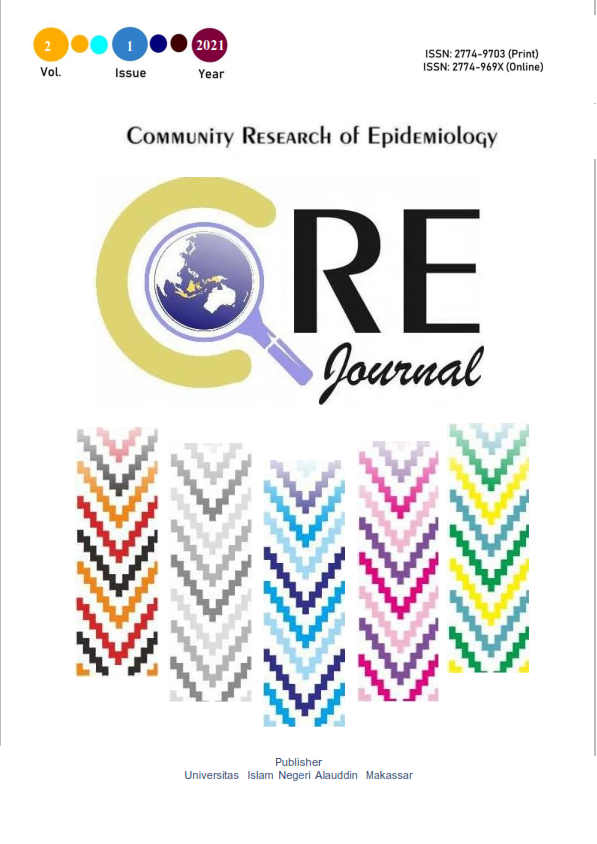Celery powder drink as an alternative treatment for hypertension
Abstract
Celery is a herbal plant often used to lower blood pressure because some of the compounds in this plant has a role as an anti-hypertension and the side effect is quite minor. The freshness of celery plant only lasts for 8 to 12 hours after being harvested, so it needs to be developed into a ready-to-drink beverage product such as a powder drink. The purpose of this study was to determine the formulation, antioxidant profile and shelf life of celery-based powder drink. This study is laboratory based descriptive. Celery-based powder drink was screened for its possible antioxidant compounds such as alkaloids, flavonoids, phenolic, triterpenoid, steroids, and saponins. The DPPH assay is used to analyze antioxidant activities. ASLT method with Arrhenius design is used to determine the shelf life of celery-based powder drink. The changes in the quality of the product were being observed for 14 days in 3 different storage temperature. Results: The antioxidant screening tests show the presence of alkaloids, flavonoids, phenolic, triterpenoid, steroids, and saponins in celery-based powder drink. Moreover, this sample showed the high antioxidant activities with the IC50 value of 70,74 ppm. The shelf life of celery-based powder drink can not be calculated because the water content of the sample is higher than SNI standards. Celery based powder drink contain antioxidants and showed the high antioxidant activities. Drying process needs to be done using other methods to produce better quality of powder drinks.
References
Ahlan. (2016). Penentuan masa kadaluarsa produk serbuk minuman instan labu siam (sechium edule se.) dengan menggunakan metode aslt (accelerated shelf life test) pendekatan model Arrhenius. Universitas Hasanuddin makassar.
Anayani O, A. S. (2019). Penentuan masa simpan kopi bubuk dalam kemasan aluminium laminated polyetilen (ALP) dan polyetilen ptalat (PET). Jurnal Dinamika Penelitian Industri, 30(2), 148–153.
Arief UM. (2016). Aplikasi kontrol PID untuk kontrol suhu dan humidity pada sistem pengeringan seledri. Jurnal Teknik Elektro, 25(2), 189–198.
Arizka AA, D. J. (2015). Perubahan kelembaban dan kadar air the selama penyimpanan pada suhu dan kemasan yang berbeda. Jurnal Aplikasi Teknologi Pangan, 4(4), 124-129.
Asmawati N, Purwati, H. R. (2015). Efektivitas rebusan seledri dalam menurunkan tekanan darah pada lansia penderita hipertensi di posyandu lansia kelurahan pajar bulan kecamatan way tenong lampung barat. Jurnal Kesehatan, 6(2).
Bunardi C. (2016). Kualitas minuman serbuk daun sirsak (Annona muricata) dengan variasi konsentrasi maltodekstrin dan suhu pemanasan. Universitas Atma Jaya Yogyakarta.
Dasuki, Maulani, Z. M. (2018). Pengaruh pemberian jus buah belimbing wuluh (Acerrhoa Bilimbi L.) terhadap penurunan tekanan darah pada penderita hipertensi di puskesmas rawasari kota jambi. Jurnal Wacana Kesehatan Akper Dharma Wacana., 3(1), 260–269.
Donna BP, Wijaya LS, Syahid MA, Karina SW, H. Y. (2018). Ekstrak daun seledri (ex-sel) dalam kemasan ekonomis siap minum untuk terapi hipertensi. Jurnal Abdi Insani Unram., 5(2), 1–6.
Hariyadi. (2019). Masa simpan dan batas kedaluwarsa produk pangan. PT. Gramedia Pustaka Utama;
Herawati H. (2008). Penentuan umur simpan pada produk pangan. Jurnal Litbang Pertanian., 27(4), 124–130.
Laporan riskesdas, (2018).
Marliana E, S. C. (2011). Uji fitokimia dan aktivitas antibakteri ekstrak kasar etanol, fraksi n-heksana, etil asetat dan methanol dari buah labu air (Lagenari siceraria (Molina) Standl). Jurnal Kimia Mulawarman. 2011, 8(2), 63-9.
Masithoh RE, F. R. (2014). Karakteristik parameter kualitas bubuk tomat selama penyimpanan pada berbagai suhu dan jenis kemasan. Jurnal Teknologi Pertanian., 15(3), 185–190.
Pisoschi AM, Cheregi MC, D. A. (2009). Total antioxidant capacity of some commercial fruit juices: electrochemical and spectrophotometrical approaches. Molecules., 14(1), 480-93.
Robinson, T. (1995). Kandungan organik tumbuhan tinggi (edisi ke-6). ITB;
Sholikhah RM. (2016). Identifikasi senyawa triterpenoid dari fraksi n-heksana ekstrak rumput bamboo (lophatherum gracile brogn.) dengan metode uplc-ms. Universitas Islam Negeri Maulana Malik Ibrahim Malang:
Svehla G. (1990). Buku teks analisis anorganik kualitatif makro dan semimikro. (Penerjemah: Setiono L dan Pudjaatmaka AH. (ed.); Edisi keli). PT Kalman Media Pusaka.
Swadana AW, Y. S. (2014). Pendugaan umur simpan minuman berperisa apel menggunakan metode accelerated shelf life testing (ASLT) dengan pendekatan Arrhenius. Jurnal Pangan Dan Agroindustri., 2(3), 203-13.
World Health Organization. (2018). Noncommunicable diseases: country profiles.


